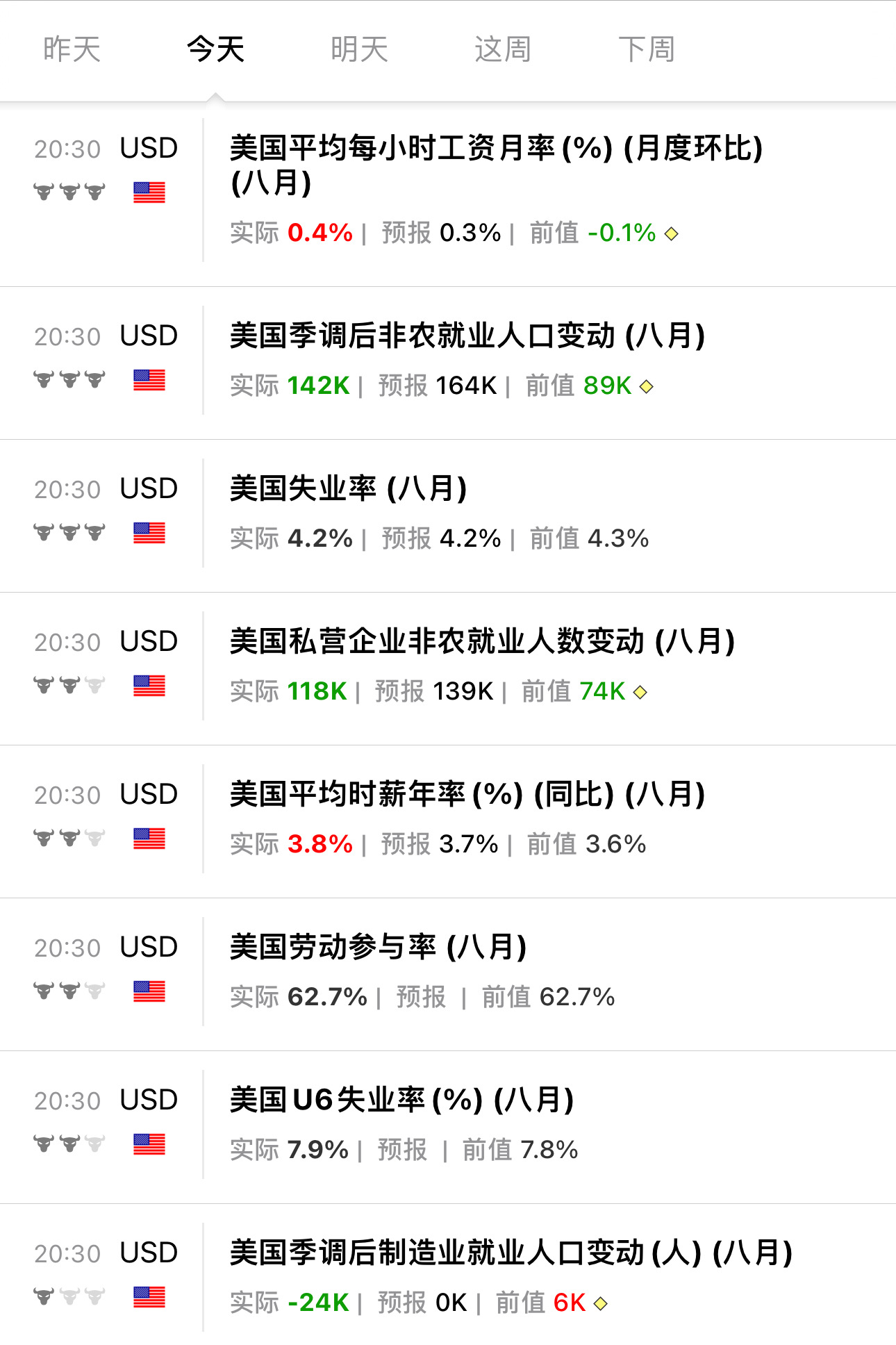USA August non-farm employment data report
Here are some key indicators and interpretations:


1. Non-farm employment.
Change
- Seasonally adjusted non-farm employment increased by 142K, lower than the expected 164K, but higher than the previous value of 89K.
- Private sector non-farm employment increased by 118K, also lower than the expected 139K, indicating a slowdown in hiring in the private sector.
- Government employment increased by 24K, higher than the previous value of 15K, indicating relatively stable hiring in the government sector.
- Analysis: Overall, non-farm employment data is below expectations, but has improved compared to the previous month, indicating a slowing job market without significant deterioration. Employment growth in the private sector is slightly weak, which may reflect concerns about the economic outlook.
2. Unemployment rate
- The unemployment rate is 4.2%, consistent with expectations, slightly lower than the previous value of 4.3%. At the same time, the U6 unemployment rate (including underemployment) is 7.9%, slightly higher than the previous value of 7.8%.
- Interpretation: The stability of the unemployment rate indicates that the labor market still has resilience. Although employment growth has slowed down, the unemployment rate has not risen significantly. This means that the overall condition of the labor market is still relatively strong and there has not been a serious deterioration.
3. Wage Growth
- Average hourly wages increased by 0.4% month-on-month, higher than the expected 0.3%.
- Average hourly wages increased by 3.8% year-on-year, slightly higher than the expected 3.7%.
- Interpretation: The wage growth exceeding expectations indicates that there is still wage pressure in the labor market. This may make the Federal Reserve pay more attention to inflation issues, as wage increases may continue to push up consumer prices.
4. Manufacturing Employment Numbers
- Manufacturing employment decreased by 24K, far below the expected 0K, indicating that the weakness in the manufacturing sector is quite serious.
Interpretation: The declining manufacturing employment reflects weak global demand and continuing supply chain issues affecting the US manufacturing sector, which may further drag down overall economic recovery.
5. Labor participation rate
- The labor participation rate is 62.7%, unchanged from the previous value, indicating that more people are rejoining the workforce.
Interpretation: The stability of the labor participation rate indicates a balance of supply and demand in the labor market, but it does not show strong upward momentum.
Conclusion and Impact on the Future:
- Overall economic situation: This report shows that the recovery of the US labor market is slowing down, but has not entered a recession phase. The unemployment rate and wage growth remain stable, indicating that the US labor market still has resilience, despite lower-than-expected employment growth.
- Market reaction and Federal Reserve policy:
- Given that the employment data is slightly below expectations, especially the slowdown in job growth in private enterprises and the manufacturing sector, this may prompt the Federal Reserve to be inclined to continue cutting interest rates to support the economy. Therefore, there is a greater possibility of a 0.25 percentage point rate cut. If future data remains weak, further easing measures may also be implemented.
- Due to wage growth exceeding expectations, inflationary pressures still exist, which may limit the Federal Reserve's possibility of a larger rate cut (such as 0.50 percentage points) in the short term.
- Market volatility: The overall data shows a slowdown in economic growth, but it has not reached the severity of a recession. The market may experience some volatility, but there will not be a significant decline. Investors may closely monitor the Federal Reserve's next move and the trend of economic data in the coming months.
Overall, the economy is not experiencing a recession, but growth is slowing down. There is still a possibility of an interest rate cut, but the Federal Reserve needs to balance the relationship between inflationary pressure and economic growth.
- Seasonally adjusted non-farm employment increased by 142K, lower than the expected 164K, but higher than the previous value of 89K.
- Private sector non-farm employment increased by 118K, also lower than the expected 139K, indicating a slowdown in hiring in the private sector.
- Government employment increased by 24K, higher than the previous value of 15K, indicating relatively stable hiring in the government sector.
- Analysis: Overall, non-farm employment data is below expectations, but has improved compared to the previous month, indicating a slowing job market without significant deterioration. Employment growth in the private sector is slightly weak, which may reflect concerns about the economic outlook.
2. Unemployment rate
- The unemployment rate is 4.2%, consistent with expectations, slightly lower than the previous value of 4.3%. At the same time, the U6 unemployment rate (including underemployment) is 7.9%, slightly higher than the previous value of 7.8%.
- Interpretation: The stability of the unemployment rate indicates that the labor market still has resilience. Although employment growth has slowed down, the unemployment rate has not risen significantly. This means that the overall condition of the labor market is still relatively strong and there has not been a serious deterioration.
3. Wage Growth
- Average hourly wages increased by 0.4% month-on-month, higher than the expected 0.3%.
- Average hourly wages increased by 3.8% year-on-year, slightly higher than the expected 3.7%.
- Interpretation: The wage growth exceeding expectations indicates that there is still wage pressure in the labor market. This may make the Federal Reserve pay more attention to inflation issues, as wage increases may continue to push up consumer prices.
4. Manufacturing Employment Numbers
- Manufacturing employment decreased by 24K, far below the expected 0K, indicating that the weakness in the manufacturing sector is quite serious.
Interpretation: The declining manufacturing employment reflects weak global demand and continuing supply chain issues affecting the US manufacturing sector, which may further drag down overall economic recovery.
5. Labor participation rate
- The labor participation rate is 62.7%, unchanged from the previous value, indicating that more people are rejoining the workforce.
Interpretation: The stability of the labor participation rate indicates a balance of supply and demand in the labor market, but it does not show strong upward momentum.
Conclusion and Impact on the Future:
- Overall economic situation: This report shows that the recovery of the US labor market is slowing down, but has not entered a recession phase. The unemployment rate and wage growth remain stable, indicating that the US labor market still has resilience, despite lower-than-expected employment growth.
- Market reaction and Federal Reserve policy:
- Given that the employment data is slightly below expectations, especially the slowdown in job growth in private enterprises and the manufacturing sector, this may prompt the Federal Reserve to be inclined to continue cutting interest rates to support the economy. Therefore, there is a greater possibility of a 0.25 percentage point rate cut. If future data remains weak, further easing measures may also be implemented.
- Due to wage growth exceeding expectations, inflationary pressures still exist, which may limit the Federal Reserve's possibility of a larger rate cut (such as 0.50 percentage points) in the short term.
- Market volatility: The overall data shows a slowdown in economic growth, but it has not reached the severity of a recession. The market may experience some volatility, but there will not be a significant decline. Investors may closely monitor the Federal Reserve's next move and the trend of economic data in the coming months.
Overall, the economy is not experiencing a recession, but growth is slowing down. There is still a possibility of an interest rate cut, but the Federal Reserve needs to balance the relationship between inflationary pressure and economic growth.
Disclaimer: Community is offered by Moomoo Technologies Inc. and is for educational purposes only.
Read more
Comment
Sign in to post a comment
